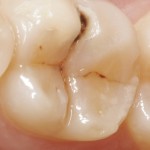We have a patient who treated himself for snoring. He saw this great ad for a device on the internet. It was fairly inexpensive and easy to use. It was made of soft plastic that you boil and then fit to your own teeth. The device was designed to bring the jaw forward so the tongue would not block the airway and thus stop the snoring. Most people could probably tolerate such a generic appliance, but for some, this may cause a problem, as in the case of our patient. (If you visit our website (https://www.cfad.net/gum-disease-treatment.html), you can learn more about how muscles, teeth, and nerves all work together for maximum function of chewing, breathing, and positioning the jaw. This is called neuromuscular dentistry. )
When the teeth are placed in an abnormal position (as with this night-time OTC snore device), it affects not only the teeth, but the muscles that control the position of the jaw. When this OTC appliance was boiled and fitted by the patient, the lower jaw was not lined up properly with the upper teeth. This torqued the jaw to the right and put stress on the left jaw joint. After wearing this devise for three months in this position at night, the left jaw joint developed clicking, popping and pain. The patient was also unable to bring his back teeth together, which put even more stress on the jaw joints and made chewing difficult. Had the patient not developed jaw pain and sought intervention, his joints might have become permently remodeled to this new position and surgery may have been required. Thankfully we were able to release the muscles with electrical stimulation (TENS) and he was able to get his teeth back together. At the Center For Advanced Dentistry, we are able to treat snoring and sleep apnea with a custom made appliance that is worn at night. This design is created using the principles of neuromuscular dentistry to prevent the onset of problems with TMD pain and other jaw problems. If you snore and want a device designed just for you that is scientifically proven to relieve the problems associated with snoring and sleep apnea, call our office today. Don’t treat yourself when the best professional help is just a phone call away.

